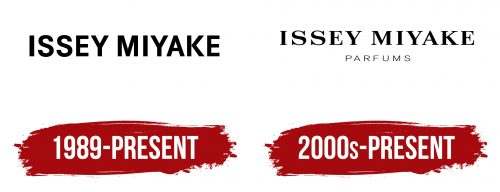The Issey Miyake logo seems barely noticeable among many others. Its appearance is simple, with clear classic motifs, lacking any elements of pretension or a drive for uniqueness. Nonetheless, it possesses a distinct beauty. It looks complete and minimalist, with simplicity giving it a unique character.
The emblem’s restraint can also be seen as a form of provocation. After all, the elegance of the identity does not bind the brand to a single stylistic direction. This is why the fashion house is always ready to offer new and unexpected products in various styles.
Issey Miyake: Brand overview
Issey Miyake’s story begins with his birth in Hiroshima, Japan, in 1938. His survival of the 1945 atomic bombing significantly influenced his perspective and later work.
Miyake earned a degree in graphic design from Tama Art University in Tokyo in 1960. After graduating, he moved to Paris to attend the École Syndicale de la Couture Parisienne, where he worked under renowned designers like Guy Laroche and Hubert de Givenchy. This experience gave him a deeper understanding of European tailoring and the world of haute couture.
In 1969, Miyake returned to Japan and founded the Miyake Design Studio, officially launching his namesake brand. From the start, he aimed to create functional and fashionable clothing. He experimented with various materials and techniques, constantly seeking innovative ways to craft garments. He debuted his first collection in New York in 1970, blending modern technology with Japanese traditions, and quickly gained recognition for his bold textile innovations and use of unconventional materials.
The 1980s were a period of growth and experimentation for the designer. In 1981, he introduced his revolutionary “A Piece of Cloth” (A-POC) collection, which redefined how clothes were produced. A-POC was a long tube of fabric that could be cut into multiple garments with little to no waste.
In 1985, he began developing one of his most famous collections, “Pleats Please.” Officially launched in 1993, the collection featured lightweight, wrinkle-resistant pleated garments that were easy to care for. “Pleats Please” became one of his most iconic and successful lines.
In 1992, the designer expanded into men’s fashion with “Issey Miyake Men,” which reflected his design philosophy of merging innovation with practicality.
The 1990s also marked his entry into the world of fragrance. His first perfume, “L’Eau d’Issey,” launched in 1992 and became a global bestseller. Inspired by the scent of water on a woman’s skin, the fragrance further solidified his reputation as a household name.
In 1994, he handed over the women’s fashion line management to his longtime collaborator, Naoki Takizawa, allowing him to focus on developing new materials and technologies. This shift helped the brand maintain its innovative edge while remaining true to its core identity.
In 1998, the company launched the Issey Miyake Watch Project in collaboration with prominent designers, continuing the tradition of blending inventive design with functionality.
In 2000, the designer expanded on his A-POC concept with the “A-POC Making” project, which received widespread acclaim and was exhibited at the Musée des Arts Décoratifs in Paris.
In 2006, Dai Fujiwara replaced Naoki Takizawa as head designer of the women’s line. Under Fujiwara’s leadership, the brand continued its focus on innovation while maintaining its commitment to practicality.
In 2010, the company introduced the “132 5. ISSEY MIYAKE” collection, which featured garments created using origami techniques and 3D modeling. This collection showcased the brand’s continued innovation in combining technology with traditional methods.
In 2011, the designer was awarded the prestigious Order of Culture by the Emperor of Japan, recognizing his significant contributions to fashion and design.
In 2014, the company celebrated the 20th anniversary of the “Pleats Please” line with a special collection and exhibition highlighting the concept’s enduring appeal.
In 2016, pleating technology was introduced into menswear with the “Homme Plissé Issey Miyake” collection, which quickly gained popularity among men who valued both comfort and style.
In 2019, Satoshi Kondo was appointed creative director of the women’s line, continuing the brand’s legacy of innovation and exploration of materials and form.
Issey Miyake passed away on August 5, 2022, at 84. While the fashion world mourned his loss, his legacy continues through the company he founded.
As of 2023, the brand remains one of the fashion industry’s most respected and innovative labels. The company continues to create clothing with a focus on innovation, functionality, and artistic vision, staying true to the ethos established by its founder.
The brand’s history is of relentless creativity, bold experimentation, and a commitment to designing aesthetically beautiful and practical clothing. From the earliest collections to the latest innovations, the company has continually pushed the boundaries of fashion and technology, redefining what clothing can be. Even after the founder’s passing, the brand continues its legacy, remaining a beacon of innovation and creativity in the fashion world.
Meaning and History
What is Issey Miyake?
This Japanese brand is known for its innovative approach to textile technologies and clothing design. The brand combines modern avant-garde ideas with elements of traditional Japanese aesthetics, creating unique works beyond conventional fashion. The collections often feature architectural shapes, complex pleating techniques, and unusual materials. The range includes clothing, watches, bags, and perfumes. The brand’s signature pleating technique, which retains the shape of the clothing while providing flexibility and comfort, has become legendary. The brand is known for its focus on practicality, comfort, and timeless quality.
1989 – today
Classic style and two-tone simplicity became defining features of Issey Miyake’s identity in its early stages. Against a white background, tall, elegant letters in black with neat serifs stand out clearly. All letters are aligned in a straight row, proportional to each other, and look harmonious.
The brand’s identity embodies strict minimalism in its precise and refined form, creating an effect of timelessness while also conveying a sense of absolute stability. The scale of the text element communicates the brand’s reliability and high competitiveness. The logo does not aim to attract attention; rather, it serves as a distinctive mark that reflects the essence and uniqueness of the brand.
2000s – today
The designer’s name is rendered in black letters on a white background. The brand name appears as if engraved on a light canvas, giving the text block a neat and appealing look. Delicate serifs lend each letter sophistication and a unique charm, emphasizing the individuality of each character. Narrow letters, clear lines, and a harmonious blend of curves and serifs create an impression of additional decorative elements. The emblem is rooted in a classic style, yet the letters, like high-tech elements, embody a revolutionary approach.
Examining each letter brings a desire to appreciate the perfection of the next. Images of the finest creations instantly come to mind when they all form the brand name. The beautiful Issey Miyake logo is free from excessive information and meanings; it exists almost outside of time, embodying the eternity and stability that have become defining traits of the brand’s modern identity.






